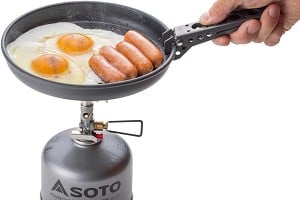
Camp catering often consists of simply boiling water and pouring it into a pouch of dehydrated stew or a cup of hot chocolate. For that you might go for an all-in-one stove system. But if you want to save weight, or cater for a couple of people, or indulge in some actual al fresco cookery, then it may be worth investing in decent lightweight cookware - preferably something that will last.
Aussie brand Sea to Summit have an extensive catalogue of cookware and dinnerware, and for weight-conscious backpackers and mountaineers the new Frontier series is the top of the range, combining lightness, durability and quality design. It's by no means a budget option, but the prices are roughly comparable to top-end offerings from rivals such as MSR.
Frontier Ultralight Two Pot Set - £130
Cookware is hard for most of us to get into much of a stew about, and don't get me wrong, £130 is a lot to spend on a couple of cooking pots - significantly more than I can remember ever paying for domestic everyday saucepans. But these lightweight aluminium pots have a real quality feel, and should last years. If you're a regular camper, particularly one for whom lightness and toughness are equally important, then you may well feel they repay the investment.
While we've been using the two-pot set, (1.3L and 3L) the pot is also available singly: 1.3L (£65); 2L (£70); and 3L (£75).
Weight and packability
For easy carrying the set nests neatly, one pot inside the other, while a small gas canister, compact folding stove and stove support will easily fit in the smaller pot (with spare room for some coffee or soup sachets). The detachable handle can be reversed, locking the lid on to prevent things spilling out into your pack, a feature I really like.
Full set - On the usually-accurate kitchen scales I make it 577g for the two-pot set, plus a soft cloth that came with them (to prevent them knocking when nested together). Sea to Summit's quoted 516g is optimistic.
3L pot - 323g including handle and lid
1.3L pot - 228g including handle and lid
Generally, and all else being roughly equal, the lighter things are the more they cost. That certainly seems to be the case here; you are getting a very light setup, given its durable feel, but yes you're paying a premium for it. On recent solo walks I've just used the 1.3L pot, which is plenty big enough for one person to boil water or cook a meal, and that 228g is really not a lot for backpacking. Similar-sized pots from the likes of MSR and Primus are roughly comparable in weight, and I'd say the Frontier range are at the sturdier end for what they weigh.
The handle alone is 59g, which seems quite heavy, but you do want something substantial, and you can't sensibly use the pot without it.
Capacity - don't judge a pot by its cover
I actually think the numbers on the side, and Sea to Summit's descriptions, are potentially misleading. While the '1.3L' pot does indeed hold this amount, it will be full to the brim and only staying in thanks to surface tension. For practical purposes its maximum capacity when heating water is more like 1L. Likewise, you're not going to be able to boil a full 3L in the '3L' pot; think more like 2.5L.
Design
The hard-anodized aluminium pots feel very sturdy for something this light. Inside is a ceramic non-stick coating, which should make the clean-up easier if you've been heating a curry or creating a dish from scratch rather than just boiling water. While it feels durable, if you're cooking you do need to use a soft utensil to avoid damaging the ceramic. Aluminium cooking pots, and the ubiquitous Teflon non-stick coating, both have potential - if debated - health implications, and I might personally be wary of some cheaper camp cookware as a result. However the hard-anodizing used here should lock in any alloy, while ceramic coatings don't have Teflon's reputation (warranted or otherwise). For me that's a good reason to invest in something quality like this.
I love the reversible handle, which locks into place with a reassuring snap. If you're draining pasta, the metal lid has straining holes, and a little heat-resistant silicone handle to hold it with. On the underside of the lid, this handle has a lip that doubles as a retainer to hold the lid on the side of the pan. This is the only feature that doesn't seem to work that well unless you're standing the pot on a dead-level surface (usually in short supply outdoors).
Frontier Ultralight Collapsible Dinnerware Set (2 Person, 6 Piece) - £90
Silicone bowls and cups that collapse into a flat disc are a good space saver in a rucksack. I use them a lot, especially the cups (if you're really watching weight then you won't bring a bowl since you can eat straight from the pan). While of course you can fill a solid mug with spare socks, it never seems to pack quite as neatly.
I reviewed an original set of Sea to Summit's collapsible cookware and dinnerware nearly a decade ago. Though cheaper alternatives are now readily available, the quality of this range has always seemed a cut above. Some of the old items are now a bit battered, but it may be telling that I still often use many individual bits all these years later, especially the collapsible cups and kettle. While it was never either the cheapest or the lightest, it's good stuff that has lasted very well.
Cost
We've got the 2-person, 6-piece set. Again, it's at the upper end price-wise for dinner ware (and significantly more than I'd spend on tableware at home) but a one-person set is also available (£45) and items can be bought separately too - the cup, for instance, is £14, and that may be all you require.
Weights and sizes
Though it's great to have dinnerware that squashes down for easier packing, the first generation weren't really all that light. But thanks to the use of thinner materials, the new fully revamped range has shed weight - bowls, for instance, are now 30% lighter than the originals, yet hold more food. The cup, meanwhile, has dropped from 70g to 53g - a modest saving perhaps, but every little helps when you're backpacking or mountaineering.
I think this does now count as a lightweight set; I make it only 390g all-in for the six pieces, and they collapse to just 17mm thick, which isn't going to take up much space in a pack. As with the pots, the capacities quoted on the base of each piece are wildly ambitious though.
Cup - this weighs just 53g, which makes it a genuinely ultralight choice if it's used alone, without the rest of the set. On the cup you get a scale up to 250ml (and the arcane US measurement of 8 fl oz). Stamped on the bottom is 400ml, but that's generous and in use I'd say the effective max is 300ml.
Small bowl - weighs 63g. The official size is 680ml, but if you can get more than 400ml of liquid in without spilling it and scalding yourself, you'll be doing well.
Large bowl - weighs 79g. Though Sea to Summit say 890ml, in the real world with a bowl of hot soup you're going to be at the limit around 600ml. The shape is wide and shallow, quite dish-like as bowls go, and in a sitting-around-the-tent context it's probably better for rice and chilli than consommé.
Design
This new design is a very clear refinement on the now-clunky-looking originals. The silicone is BPA-free and heat-resistant, and with the addition of extra reinforcing rings (now a lot thinner on the cup than previously), the new Frontier Collapsible range is also sturdier and less floppy than before, which is good when you're juggling a bowl of dinner. And here's a clever touch: the curvature of the bowls perfectly matches the shape of Sea to Summit's spoons, so you can scrape out every last smidgin of dahl. It's the little details that count.
Frontier Ultralight Knife, Fork and Spoon Set - £22
I didn't imagine I could get excited about outdoor cutlery until I saw this little set. Made of hard anodised aluminium, with a nice matt finish and a satisfying hint of mid-century Scandi design, this knife, fork and spoon set is pretty damn pricey as these things go, but featherlite and sturdy. The knife's serrations are usefully keen; the fork's tines are just right; the spoon is, well, a very nice spoon.
Are they a must-have when much cheaper plastic or metal alternatives are readily available? Not at all. Do they match the one-piece versatility of a spork? Not really. Do I, entirely out of character, notice myself enjoying using them? Yes. Yes, I do.
These come with a neat little carabiner to keep the set together; watch out, it's hidden in the packaging and easy to throw into the recycling bin by mistake (speaking from experience).
Weights
Full set including clip - 27g
Spoon - 10g
Knife - 7g
Fork - 7g
Other sets and individual items are available in the range, including sporks and long-handled cutlery. If you're not wildly keen on ingesting aluminium (me neither), it's worth noting that as with the pots, the hard anodising process forms a sort of 'shell' that stops the alloy leaching into your food.
















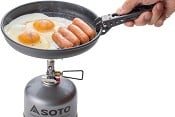


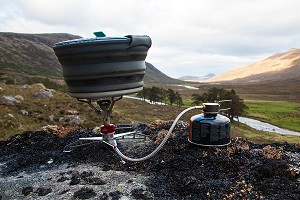
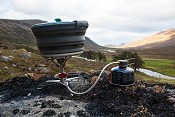
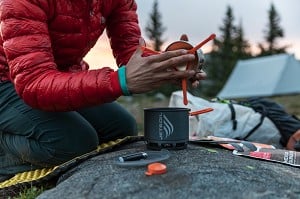
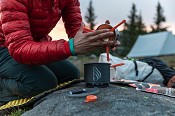
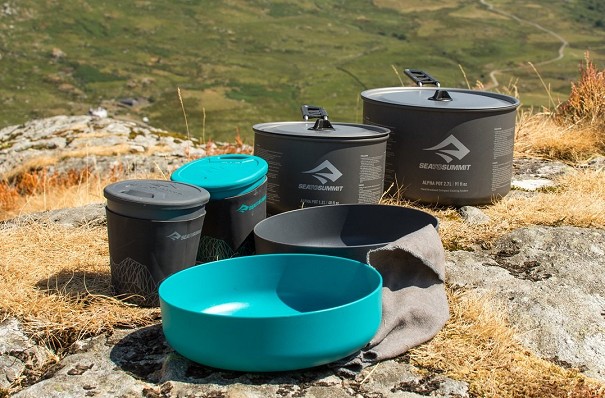


Comments
A little inaccurate on the Teflon in your review. In its inert form i.e. as a coating it’s about as harmless as you can get. It’s only when superheated at above 260c and when it breaks down giving off fumes, does it become noxious and harmful.
Aluminum cookware tends to be anodised to make it tougher and more resistant to damage. As for aluminium leaching and Alzheimer’s, that’s unproven and a bit of an urban myth.
Is that ME puffy on review too?
Yes, that's the Oreus (due out autumn/winter24). We've got a couple of them on long term review
Interesting, thanks. I'd best do some more reading (not usually that easy to spot sound info from dodgy sources, on the web)
There will be a pro chemist here on UKC that will be able to give a far better view than I can :) I know about the aluminium purely from mom having had Alzheimers and having researched it thoroughly back in the day.